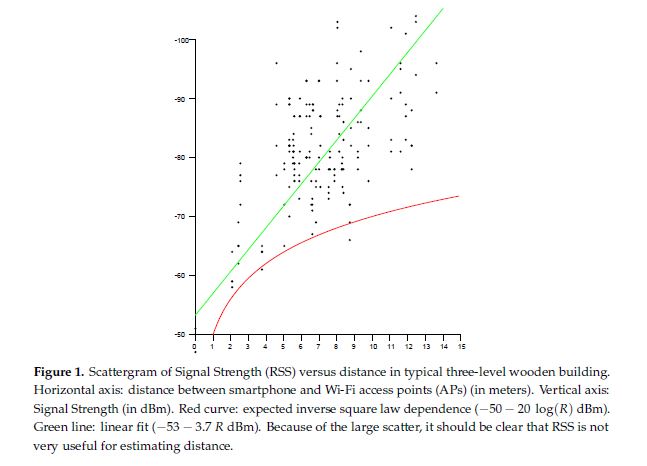Hi everyone, I would like to ask:
would an Indoor Positioning that is based on UWB RSSI be expected to perform better compared to ones that are based on BLE RSSI? Are UWB RSSIs more stable (or less prone to interference/multipathing/etc) compared to the BLE corresponding ones?
We have not done actual scientific experiments in this area, so these comments are based on general experience. With that disclaimer, I would not expect UWB RSSI to work as well as BT RSSI for correlating distance. The primary reason is that the RSSI numbers seem coarse and somewhat noisy.
In theory, using only the first path numbers would avoid using multipath energy in the RSSI. But I think that falls down in two ways. First, the the first path signal strength numbers are relatively coarse, so there is a lack of detail. Second, if the first path was not detected properly, a multipath signal will be interpreted by the DW1000 as the first path and thus produces a reading not truly representative of the first path RSSI.
I suspect using long preambles, which take more transmit time, probably improves the RSSI numbers somewhat, but that’s just a guess.
If you try this, please let us know your results, it is an interesting topic that could have applications in peer to peer ranging functions.
Mike Ciholas, President, Ciholas, Inc
3700 Bell Road, Newburgh, IN 47630 USA
mikec@ciholas.com
+1 812 962 9408
I was looking at using RSSI as a proxy for distance and did some research on that.
The answer is that is correlates; but, very poorly thus it is a poor proxy for distance.
Here is a good article with some insights on that Doubling the Accuracy of Indoor Positioning: Frequency Diversity - PubMed the article is for WiFi rather than UWB but it still was enough for me to abandon that approach. This graph is from that article

There are fundamental differences between Wifi and UWB such that the above article would not, in itself, convince me that UWB RSSI is not useful.
For one thing, UWB has the concept of first path energy versus total path, something that Wifi can’t do at all.
From our testing we did years ago plotting RSSI versus distance, it didn’t look like RSSI was going to be useful as a distance indicator.
Mike Ciholas, President, Ciholas, Inc
3700 Bell Road, Newburgh, IN 47630 USA
mikec@ciholas.com
+1 812 962 9408
From our testing we did years ago plotting RSSI versus distance, it didn’t look like RSSI was going to be useful as a distance indicator.
I agree there are substantial differences between WiFi and UWB but there are also substantial similarities. In RF, for one thing, frequency does matter quite a bit. Light (very high frequency RF) can’t go through walls; but, other lower frequencies can. HF can skip off the ionosphere while higher frequencies don’t, etc. etc. etc. But, the scattering they were seeing here was so bad that I could see no way RSSI would correlate well enough for what we wanted. Note: At the time the frequencies we were considering was in the WiFi range and I wanted to use ToF from the beginning; but, GPS was not sufficient and I did not know of any other low cost commercial RF products that could measure ToF. Note also that is is not the only report I looked at. For our case, the information in this article was sufficient and worth sharing so that is all I have shared.
Hi all, I tried doing this experiment and the problem is that the RSSI and FPPL measurements are already corrected by the AGC in the dw1000, so that the result is basically uniform.
I thought about two possibilities to overcome this issue:
- Measuring the AGC gain and compensating in the FPPL/RSSI measurements -> I haven’t found any documentation about measuring the AGC gain nor if it is possible at all;
- Disabling the AGC -> The documentation about the AGC tuning registers is insufficient.
It would be nice if someone from Decawave could provide any information in this regard.
Please, let me know in case you have other ideas.
BR,
Leo.